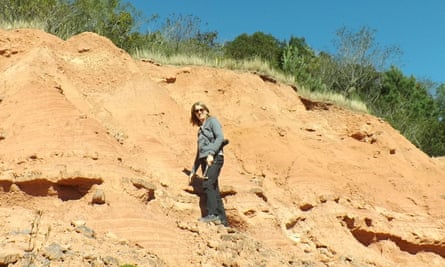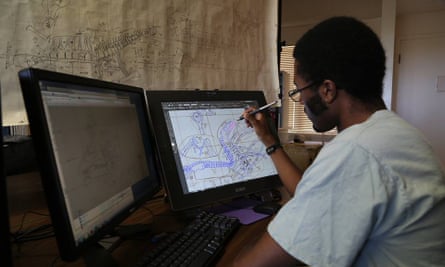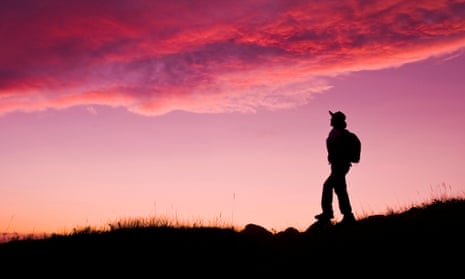As I eye myself in the mirror before heading off to the office for another day of palaeontological research, I wonder: ought I to be wearing a hat? Preferably wide-brimmed, even a Stetson. I button up my teal cardigan – shouldn’t that be a checked shirt? Or a t-shirt with a T rex meme emblazoned across the front? And where are my hiking boots? No-one ever studied extinct animals in a skirt and tights now, did they?
“She’s too well dressed to be a palaeontologist,” a male colleague recently commented to me, regarding a leading female researcher. It was said in jest, but I was troubled by the inference that there was a “correct” way to dress for our job. I found myself wondering: do I fit in with my colleagues? Does a desire to colour-match suggest you’re a less dedicated researcher?
Like all stereotypes, it’s a dangerous thing if it leads to exclusion.
Palaeontologists have acquired a set of stereotypes, many shared with other Earth scientists. They are not entirely unfounded. When visiting geology departments – where palaeontologists are often ensconced – I’m baffled by the prevalence of outdoor-gear worn by researchers. Are the departments sponsored by Tiso? These academics look ready to trek from the tea-room to the Trossachs at a moment’s notice. Forget that most walk no further each day than the distance from their suburban home to their desk; should a geological emergency occur that urgently requires sedimentary logging, they’ll be prepared.

In some ways the rugged outdoorsiness associated with palaeontology and Earth science provides liberation. Women in particular revel in the opportunity to remind a still sceptical society that they, too, can trudge into the wilderness and jackhammer a dinosaur from a rock face. The right to be a trowelblazer is not the preserve of the bearded.
At last year’s Society of Vertebrate Palaeontology (SVP) meeting, I walked past a row of photographic portraits in the lobby, depicting men in outdoor settings. From their classic garb, I could tell they were Earth scientists. All of them had beards. Many clutched field equipment. I must have walked past the pictures ten times before I noticed that one of them also had breasts. Big round boobs, pushing out from under his checked shirt. I stopped to examine the pictures more closely. They all had breasts.
These portraits are part of The Bearded Lady Project. Not all of these bearded ladies were clad in Gore-Tex and wide-brimmed hats: I noted one whose wavy blonde beard matched her loose hair, and she was in leggings, clutching a yapping Pomeranian. In another portrait three young bearded ladies were clustered around a flatscreen monitor. Another was in a nondescript laboratory. Several were in museums, standing over the collections. The brainchild of Lexi Jameison Marsh, Dr. Ellen Currano, and Kelsey Vance, the Bearded Lady Project celebrates women geoscientists while also challenging stereotypes. Their portraits capture leading ladies in their disciplines, all of whom have donned beards to remind us of our ingrained preconception of what an Earth scientist is “supposed” to be.

In 2014 the Royal Society published a hard-hitting report on the state of diversity in science; clearly outlining the underrepresentation of women in senior positions, the difficulties for career progression for black and minority students after graduation, and the effect of poorer socio-economic backgrounds on a person’s ability to enter the scientific workforce. In Earth science, although almost half of PhD students are female (47%), women make up only 10% of professors (figures for 2011/2012). Although there may be a lag – things have improved, but the next generations haven’t reached that career stage yet – these data suggest that despite this caveat there is still a worrying drop in women at the top, representing a huge loss of talent in the upper levels of academia.
Recognising women in palaeontology, geology and archaeology, not only illustrates that women are equally tough and comfortable in the outdoors, but conversely reminds us that not all palaeontology, geology and archaeology has to be tough and outdoorsy. This is not because women bring some kind of innate femininity to the Earth sciences - there is no such thing. But they do contain 50% of human variation. Recognising their contribution and diversity opens the doors to the diversity of both genders. Women can be rugged diggers, just as men can be quiet museum-rifflers.
“I do think that stereotypes persist in the general public,” explains Professor Emily Rayfield, “who commonly associate the practice of palaeontology very specifically with digging up dinosaurs.” Rayfield, professor of palaeobiology at the University of Bristol, is especially interested in diversity in her roles as vice-president of both the Society of Vertebrate Paleontology (SVP) and The Palaeontological Association. SVP’s annual conference in 2016 saw the most diversity among participants to date; “you just have to look around any conference to see that palaeontologists come in many guises, and amongst professional palaeontologists there is no obvious stereotypical palaeontologist.”
Rayfield represents the scientist many people in their early careers aspire to. She has not only achieved a top academic position, but pioneers incorporating computational methods and new technology into her research – approaches that have revitalised palaeontological practice in the last ten years, and made it far more diverse and inclusive. “The emergence of new technologies and methodologies mean that we can understand so much more about how extinct animals evolved and functioned,” she explains. “Modern palaeontology is an extremely diverse subject, and people with a background in many different subjects - maths, computing, molecular biology - can provide valuable contributions to palaeontological knowledge.”

I asked her if she thought the old stereotype of the white bearded palaeontologist hacking out bones in the desert, might discourage some people from pursuing it as a career. “Palaeontology will always rely on fieldwork to uncover new fossils. As a parent of small children with a partner who also works full time in a demanding job, at the moment it suits me not to have to spend weeks away from home in the field. Likewise for individuals who may find fieldwork physically challenging, new computational methods offer an alternative research focus.”
Any marketer will tell you: image matters. In palaeontology it matters because potential students may be turned off if they believe they have no place in the discipline because they don’t fit in. It also matters because serious funding bodies don’t distribute their cash to researchers just because they find cool bones. It is the painstaking science that emerges from hours at the desk: reconstructing fossils using visualisation software; combing through the previous literature; carrying out analyses on comparative morphology; and mathematically calculating rates of evolution. It is also about examining both museum collections, and living animals. Even the fathers of comparative anatomy who described many of the first fossils, were mostly desk jockeys.
The European Association of Vertebrate Paleontologists (EAVP) is also keen to address the lack of diversity in their research area. At their recent conference in Munich, they held a workshop on gender stereotyping and inequality. Over fifty researchers attended, half of them male. I spoke to one of the workshop organisers, Femke Holwerda, about the outcomes. “Two main issues were identified: problems that arise from short-term grants for men and women who are parents as well as scientists, and stereotyping between men and women from a very early age onwards. Stereotypes come from society and culture, not from biological differences. Enhancing mechanisms are, for example, toys, books, and clothes. Toys are a particularly good example - girls, for instance, are systematically discouraged from playing with ‘construction’ toys that give boys their early spatial insight and mathematical skills, and boys are systematically discouraged from playing with ‘caring’ toys that give girls more empathy and force them into caring roles, and discourage boys from engaging in the same roles.”

Holwerda is a PhD candidate at the Bayerische Staatssammlung für Paläontologie und Geologie in Munich. She was one of the key organisers of the 2017 EAVP conference, and the workshop. “The overwhelming majority of presenters at conferences are men,” she says. “We need to encourage young women to participate more actively, giving regular talks and keynote talks, instead of going for posters as recent numbers show.” I asked her why she thought more female researchers chose printed posters rather than delivering talks. “Young women are less sure of their scientific worth, and this might trace all the way back to the cultural stereotyping they’ve been exposed to. A little encouragement goes a long way. Again, role models, mentoring and supervisors play an important role here.”
Has Holwerda encountered the white male stereotype of palaeontology? She nods, “mostly harmless but annoying stereotypes, such as where I need to explain why I can perfectly easily wear a dress to work, as I’m not about to dig up a dinosaur from behind my computer. Or where colleagues in museums need to explain why they don’t have to wear a labcoat all the time. It gets more serious however, when I have to answer questions like: ‘you’re a girl and do girly things, but you’re also a palaeontologist, how is that possible?’”
Few people deny the value of working to include and keep talented women in science. But the problems with the representation of women in Earth sciences pale in comparison with the scale of underrepresentation of black and minority groups. One of the figures from the report by the Royal Society, was that over 95% of UK Earth scientists are white.
“I know of no other black, full-time, Earth science academic in the UK - or in fact, Europe or the US,” Professor Christopher Jackson from Imperial College London tells me. “I chose to do Earth science simply because I enjoyed it at A-Levels. At that time, I had little idea about the ‘colour’ of Earth sciences, or colour in general.” Jackson grew up in a largely white area, in a largely white city, “as such, I had few black role models, beyond my Mum and Dad. I guess I understand why many potential Earth scientists coming from minority groups are put off from taking this degree due to the lack of role models.”
Our outward appearance can’t help but influence how we interact with the world around us, and who we relate to. “The US-based National Association of Black Geoscientists provide inspiration, practical advice, funding and mentorship to black students,” Jackson explains. “They - and many other groups - are trying to at least partly dispel the myth that you need to be ‘outdoorsy’ to do Earth sciences, or that you need to like camping, or wearing Gore-Tex, or like rocks. The subject is vast and there are lots of Earth science sub-disciplines that may appeal to a leather-wearing lab-rat.”
I asked Jackson who he has turned to for inspiration. “My personal role models take many forms in terms of race, ethnicity and gender, but these people all share one same characteristic: they are positive, progressive, and simply want to better understand the Earth.”

At the other end of the career spectrum, I met fellow PhD student Ben Otoo in the Chicago Field museum. I knew of him previously from his exceptional work reconstructing fossils from the Scottish borders as part of the TW:eed project. I asked him whether there was still a stereotype in Earth science. “Geology is a very archetypically white, manly-man sort of thing - denim, mountain-man beards, the great outdoors, dust, dirt, lifting heavy things, sweating ...” He laughs, “that picture obviously isn’t accurate, and there are many different sorts of people in geology, but it’s still the dominant cultural reference point.”
Otoo is one of only two black students on his programme at the University of Chicago, and together they comprise half of all the black students who’ve ever been on the programme. As an early-career palaeontologist, I asked him about his experiences so far. “Academia in general is very white and very male, so even if you get past all the access filters – and there are many – if you’re not one of those things the environment is quite inhospitable. That doesn’t mean that people are necessarily hostile or difficult, but the environment isn’t meant for people like you. You can get by, but you have to bring your own oxygen, so to speak. And because there are so few people in the field who aren’t white men, especially among the big names, you’re really on your own.”
So, what can be done to address the lack of diversity still prevalent in Earth sciences? Professor Jackson feels the problem starts early: “in my view, to address this issue doesn’t simply require rebranding of Earth sciences to compete with ‘classic’ sciences such as maths and physics. For people of colour presently studying, teaching, and researching Earth science, academics like myself must provide them with positive role models and mentorship. Before then, the socio-economic issues associated with academic under-achievement in schools must be identified and tackled.”
“I like to think that by doing this, as somebody who moves through the world as I do, it’s a testament to the fact that it’s possible” says Otoo. His enthusiasm is uplifting: “I’m not saying that I’m going to revolutionise palaeontology, or be canonized as one of the greats or anything, [but I’m] not just a hypothetical that can get brought up and then forgotten in a meeting or a speculative conversation. I’m an actuality; a real living person. Hopefully that counts for something.”
Otoo and Jackson both identify the importance of the actions of the individual. Palaeontologists and geologists often find themselves falling back on the stereotypes when communicating about palaeontology, because we are also quite proud of our rock-hound heritage. But let’s make sure the generations that follow us aren’t restricted by our attachment to this meme. Whether you want to programme algorithms in your action-sandals, or cling to a rock face with full make up (neither of which are gender specific), it’s time to embrace the full range of what being a palaeontologist – or any kind of scientist – can be.
I take comfort in knowing there are many who want to celebrate and encourage the diversity of people, approaches, and scientific contributions among earth sciences. You can never be too well-dressed – or pregnant, or black, or languid, or LGBTQ+ - to be a palaeontologist. You don’t even have to wear a hat.

Comments (…)
Sign in or create your Guardian account to join the discussion